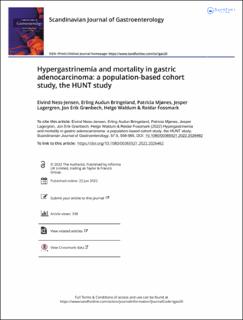| dc.contributor.author | Ness-Jensen, Eivind | |
| dc.contributor.author | Bringeland, Erling Audun | |
| dc.contributor.author | Mjønes, Patricia | |
| dc.contributor.author | Lagergren, Jesper | |
| dc.contributor.author | Grønbech, Jon Erik | |
| dc.contributor.author | Waldum, Helge | |
| dc.contributor.author | Fossmark, Reidar | |
| dc.date.accessioned | 2023-05-19T08:39:39Z | |
| dc.date.available | 2023-05-19T08:39:39Z | |
| dc.date.created | 2022-04-22T13:28:43Z | |
| dc.date.issued | 2022 | |
| dc.identifier.citation | Scandinavian Journal of Gastroenterology. 2022, 57 (5), 558-565. | en_US |
| dc.identifier.issn | 0036-5521 | |
| dc.identifier.uri | https://hdl.handle.net/11250/3068301 | |
| dc.description.abstract | Purpose: Hypergastrinemia increases the risk of developing proximal gastric adenocarcinoma. However, it is unclear if hypergastrinemia affects the survival in patients with gastric adenocarcinoma. This study aimed to examine the hypothesis that hypergastrinemia is associated with increased risk of mortality in patients with gastric adenocarcinoma.
Materials and methods: This prospective population-based cohort study based on the Trøndelag Health Study (HUNT) included 78,962 adult individuals (≥20 years). During the baseline assessment period (1995–2008) of these participants, serum samples were collected and frozen. All participants with a newly diagnosed gastric adenocarcinoma in the cohort in 1995–2015 were identified and their gastrin levels were measured in the pre-diagnostic serum samples. Gastrin levels were analysed in relation to all-cause mortality until year 2020 using multivariable Cox regression providing hazard ratios (HRs) with 95% confidence intervals (CIs), adjusted for sex, age, body mass index (BMI), tobacco smoking, tumour stage, completeness of surgical resection, and peri-operative chemotherapy.
Results: Among 172 patients with gastric adenocarcinoma, 81 (47%) had hypergastrinemia (serum gastrin >60 pmol/L) and 91 (53%) had normal gastrin level. The tumour location was proximal in 83 patients (43%) and distal in 78 (41%). Hypergastrinemia was not associated with any increased risk of all-cause mortality in all patients (adjusted HR 0.8, 95% CI 0.5–1.1), or in sub-groups of patients with proximal tumour location (HR 0.9, 95% CI 0.4–2.2) or distal tumour location (HR 0.9, 95% CI 0.5–1.7).
Conclusion: This population-based cohort study indicates that hypergastrinemia may not increase the risk of mortality in patients with gastric adenocarcinoma. | en_US |
| dc.language.iso | eng | en_US |
| dc.publisher | Taylor & Francis | en_US |
| dc.rights | Navngivelse 4.0 Internasjonal | * |
| dc.rights.uri | http://creativecommons.org/licenses/by/4.0/deed.no | * |
| dc.title | Hypergastrinemia and mortality in gastric adenocarcinoma: a population-based cohort study, the HUNT study | en_US |
| dc.title.alternative | Hypergastrinemia and mortality in gastric adenocarcinoma: a population-based cohort study, the HUNT study | en_US |
| dc.type | Peer reviewed | en_US |
| dc.type | Journal article | en_US |
| dc.description.version | publishedVersion | en_US |
| dc.source.pagenumber | 558-565 | en_US |
| dc.source.volume | 57 | en_US |
| dc.source.journal | Scandinavian Journal of Gastroenterology | en_US |
| dc.source.issue | 5 | en_US |
| dc.identifier.doi | 10.1080/00365521.2022.2026462 | |
| dc.identifier.cristin | 2018430 | |
| cristin.ispublished | true | |
| cristin.fulltext | original | |
| cristin.qualitycode | 1 | |

